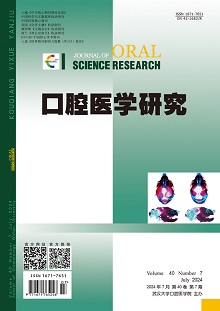|
|
Effects and Mechanisms of miR-24 on Biological Functions of Salivary-gland Adenoid Cystic Cancer Cells through Regulation of AKT/β-catenin Signaling Pathway and EMT Process
LI Lin, JI Xiaolin, JIANG Xiangrui
2024, 40(7):
640-647.
DOI: 10.13701/j.cnki.kqyxyj.2024.07.013
Objective: To explore the effect and mechanism of microRNA (miR)-24 on the biological function of salivarium adenoid cystic cancer (SACC) cells by regulating protein kinase B (AKT)/β-catenin signaling pathway and EMT process. Methods: Sixty patients with SACC admitted to our hospital from June 2021 to March 2024 were collected, and human SACC cell lines (SACC-83 and SACC-LM) were cultured. The histopathological types of SACC were detected by HE staining. The expression of miR-24 in SACC tissues and cells was detected by fluorescence in situ hybridization (FISH) and quantitative real time polymerase chain reaction (qRT-PCR). miR-24 inhibitor was transfected into SACC cells by cell transfection, and the biological behavior of SACC cells was detected by CCK-8, clonal formation assay, wound healing assay, and transwell assay. Western blot analysis was performed to detect the expression of EMT-related proteins and AKT/β-catenin signaling pathway. Results: HE staining results showed that the cancer tissue of SACC patients contained three main pathological types: solid type, cribriform type, and tubular type. Compared with paracancer tissues, miR-24 was highly expressed in SACC tissues, SACC-83 cells, and SACC-LM cells, and the expression level of miR-24 in SACC-LM was higher than that in SACC-83. miR-24 inhibitor significantly inhibited cell viability, colony formation, wound healing rate, migration, and invasion of SACC-83 and SACC-LM. After transfection of miR-24 inhibitor, E-cadherin levels were significantly increased in SACC-83 and SACC-LM cells, while Vimentin and N-cadherin levels were decreased. Conclusion: miR-24 regulates SACC cell proliferation, migration, invasion, and EMT process by regulating AKT/β-catenin signaling pathway.
References |
Related Articles |
Metrics
|

